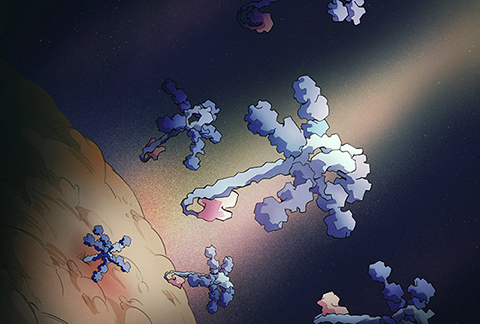New class of antimicrobials discovered in soil bacteria
Researchers have discovered toxic protein particles, shaped like umbrellas, that soil bacteria known as Streptomyces secrete to squelch competitors, especially others of their own species.
The discovery of the umbrella toxin particles and related information about their structures, composition and mode of action were published April 17 in Nature.

The umbrella toxin proteins are the latest example of these bacteria’s varied strikes on their microscopic rivals. The crowded, diverse bacteria communities in which they live are a melee of antimicrobial attacks, counterattacks and defenses.
Ironically, many clinically used antibiotics derive directly from, or are inspired by, molecules that bacteria use against each other in their natural habitat. Streptomyces’ chemical weaponry against their competitors is one of the richest sources of such molecules. Among them is the common, broad-spectrum drug streptomycin.
What makes these newly detected antibacterial toxins different is that, unlike the Streptomyces’ small-molecule antibiotics, umbrella toxins are large complexes composed of multiple proteins. They are also far more specific in the bacteria they target, compared with small-molecule antibiotics.
The authors of the Nature paper speculate that these properties of umbrella toxins explain why they escaped discovery for more than 100 years of research on toxins produced by Streptomyces.
Genes encoding umbrella toxins were originally uncovered through a bioinformatics search for new bacterial toxins. In biochemical and genetic experiments led by Qinqin Zhao in Joseph Mougous’ microbiology lab at the University of Washington School of Medicine, the scientists learned that these toxins associate with other proteins in a large complex.
Cryo-electron microscopy of these protein complexes was performed by Young Park in the laboratory of David Veesler, professor of biochemistry at the UW School of Medicine and an Investigator of the Howard Hughes Medical Institute.
These studies revealed that the toxin complexes Qinqin isolated adopt a striking appearance befitting their discovery in Seattle. They look like umbrellas.
“The shape of these particles is quite peculiar, and it will be interesting in future work to learn how their unusual morphology helps them eliminate target bacteria,” noted Mougous, a professor of microbiology at the UW School of Medicine and a Howard Hughes Medical Investigator.
The scientists then sought to determine the targets of these toxins by screening their effects on every organism they could conceivably target, from fungi to 140 different bacteria, including some taken from sorghum plants in the lab of study author Devin Coleman at the University of California-Berkeley and the U.S. Department of Agriculture Agricultural Research Service. .
Among these potential adversaries, the toxins specifically targeted their own brethren: other Streptomyces species.
“We think this exquisite specificity may be due to the proteins that make up the spokes of the umbrella, which vary across the particles. These include proteins that might latch onto specific sugars found on the surface of competitor bacteria,” commented study author S. Brook Peterson, a senior scientist in the Mougous lab.
By analyzing the thousands of publicly available bacterial genomes, study authors Dapeng Zhang of St. Louis University and his graduate student Youngjun Tan found that many other species of bacteria also have the genes to manufacture umbrella particle toxins. Interestingly, these species all form branching filaments, an unusual mode of growth among bacteria.
In addition to the many questions remaining to be answered about the basic biology of umbrella toxin particles, Mougous and his colleagues are intrigued by their potential clinical applications.
They suspect that the bacteria that cause tuberculosis and diphtheria may be sensitive to umbrella toxins. They note these same bacteria have become resistant to traditional antibiotics. Umbrella toxin particles might be worth exploring, the scientists suggested, for their potential to subdue these serious disease-causing bacteria.
This article is republished from the UW Newsroom website. You can read the original here.
Enjoy reading ASBMB Today?
Become a member to receive the print edition four times a year and the digital edition monthly.
Learn moreGet the latest from ASBMB Today
Enter your email address, and we’ll send you a weekly email with recent articles, interviews and more.
Latest in Science
Science highlights or most popular articles

Fueling healthier aging, connecting metabolism stress and time
Biochemist Melanie McReynolds investigates how metabolism and stress shape the aging process. Her research on NAD+, a molecule central to cellular energy, reveals how maintaining its balance could promote healthier, longer lives.

Mapping proteins, one side chain at a time
Roland Dunbrack Jr. will receive the ASBMB DeLano Award for Computational Biosciences at the ASBMB Annual Meeting, March 7–10, just outside of Washington, D.C.

Exploring the link between lipids and longevity
Meng Wang will present her work on metabolism and aging at the ASBMB Annual Meeting, March 7-10, just outside of Washington, D.C.

Defining a ‘crucial gatekeeper’ of lipid metabolism
George Carman receives the Herbert Tabor Research Award at the ASBMB Annual Meeting, March 7–10, just outside of Washington, D.C.

The science of staying strong
Muscles power every movement, but they also tell the story of aging itself. Scientists are uncovering how strength fades, why some species resist it and what lifestyle and molecular clues could help preserve muscle health for life.

Bacteriophage protein could make queso fresco safer
Researchers characterized the structure and function of PlyP100, a bacteriophage protein that shows promise as a food-safe antimicrobial for preventing Listeria monocytogenes growth in fresh cheeses.

